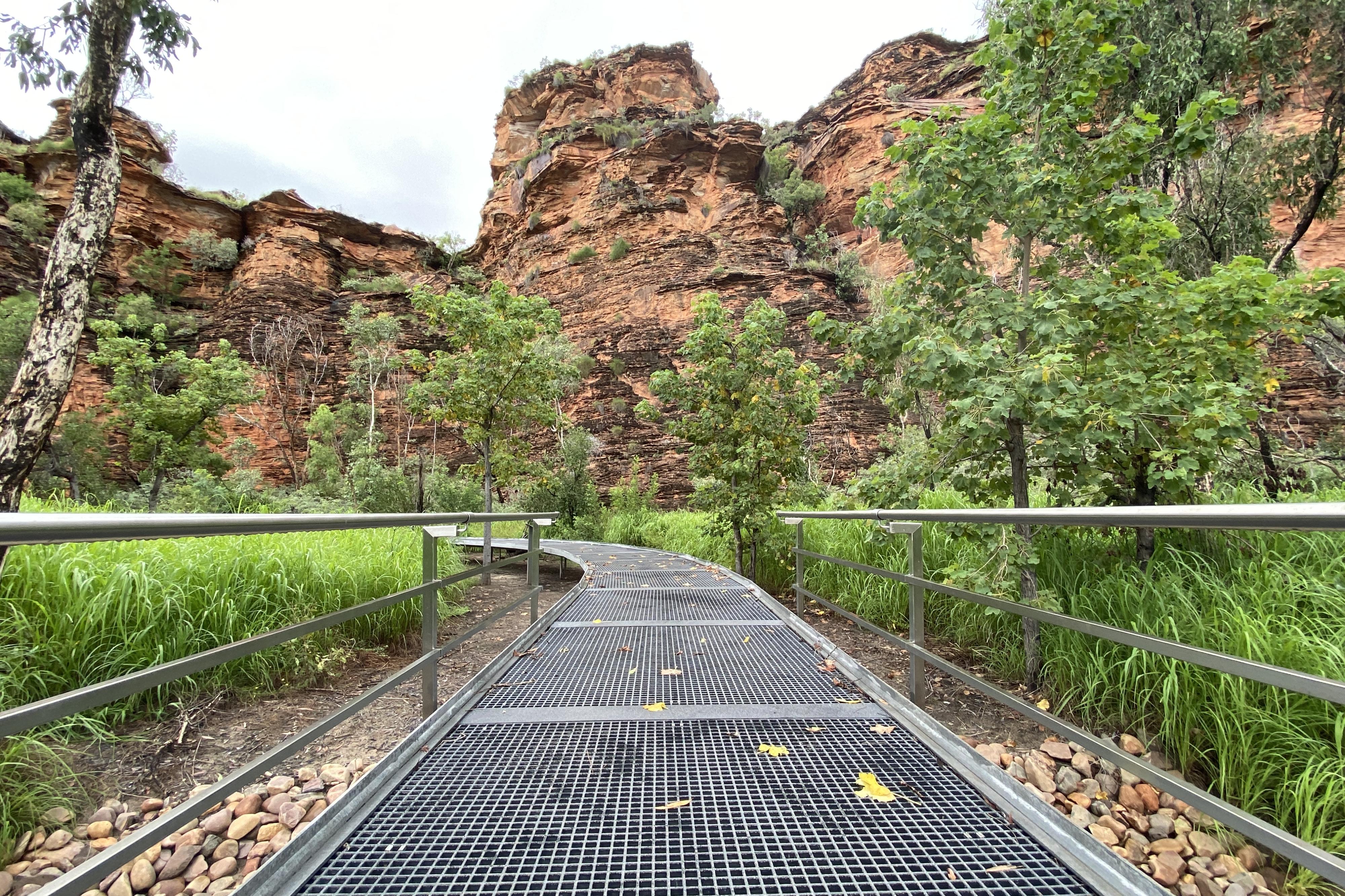Park Feature - Mirima National Park
Located on the edge of Kununurra, Mirima National Park is an outdoor museum of rock formations, which has long been culturally significant to the Miriwoong people, and continues to delight visitors today.
Covering more than 2000 hectares, Mirima National Park is on the fringe of Kununurra township. For thousands of years, the area has been significant for the Miriwoong people, who sought shelter from the sun and the wet season rains. Caves located in the park served as ideal places for overnight stays and made Mirima a significant camping area for seasonal movements. Thanks to permanent water sources, Mirima was also an important area for hunting echidnas and kangaroos. People also gathered a variety of plants for bush medicine there. Traditional ools included shovel head spears (lamang) that were launched using spear throwers (ngawaleng). The usage of tools is evident in engravings, flakes and stone tool-making sites that are still visible in the park.
“For thousands of years, the area has been significant for the Miriwoong people, who sought shelter from the sun and the wet season rains in the many caves and rock overhangs.”
Natural attractions
The park boasts spectacular rock formations, which were formed from sediments deposited by creeks and windblown sand about 300 million years ago during the Devonian period. This process has created the horizontal layers reminiscent of the Bungle Bungle Range in Purnululu National Park. These formations are protected by a thin layer of black-grey algae and lichens that resist the weathering of the fragile orange sandstone by torrential rains. These rains have also carved out the chasms and valleys that are part of the spectacular landscape.
The park is dominated by spinifex grasslands and woodland savanna's, which feature eucalypts, boabs and yellow-flowered kapok bushes. This environment supports rich birdlife with more than 110 species recorded, including waterbirds that are attracted to the permanent water source of the Ord River irrigation area. Pied butcherbirds and yellow-throated miners are permanent residents of Mirima National Park, as are the stunningly coloured variegated fairy-wrens, red-tailed black cockatoos, red-winged parrots and rainbow lorrikeets.
An abundance of frogs occurs in the area but are primarily nocturnal to avoid the heat of the day, so are seldom seen. However, after dusk, the calls of ornate burrowing, long-footed and splendid tree frogs are deafening. The park is also home to a variety of snakes, including the children’s, black-headed and olive pythons. A variety of skinks and other lizards also occur there, including the elusive chameleon dragon.
Many of the park’s mammals are also nocturnal, so are not often seen during the day. But, short-eared rock wallabies frequent the steep-sided gorges while wallaroos prefer the wider valley floors where they graze on spinifex. Agile wallabies and the northern nail-tail wallabies are occasionally seen on the grassy sandplains, while small carnivorous marsupials, such as the long-tailed planigale, Ningbing antechinus and stripe-faced dunnart emerge from under spinifex and rock ledges at night.
Exploring the park
Mirima National Park has several walk trails that lead visitors through the area. The 400-metre Class 1 ‘Looking at Plants’ trail has recently been upgraded to provide wheelchair access on a raised boardwalk and concrete path and includes an environmentally friendly hybrid toilet. The signage along the walk provides information about the plants and how the Miriwoong Aboriginal people used them. Bilingual signage helps maintain the endangered Miriwoong language and keeps it in active use for present and future generations.
Demboong Banan Trail is a Class 3, 500-metre-return walk that journeys through a gap in the range and takes in a spectacular view over Kununurra. The surface is uneven over rocky and sandy parts, but the view is worth the effort.
For a more challenging experience, the Derdbe-gerring Banan Trail provides an 800-metre journey that leads walkers up steep slopes to a lookout that takes in the Ord Valley and the sandstone range of Mirima. A new staircase and handrails provides improved visitor safety. Those looking for a longer walk can take the Gerliwany-gerring Banan Trail, which takes about an hour and gets its name from the Miriwoong words for “for walking” and “trail”. Walkers are encouraged to keep their eyes peeled for wallabies, wallaroos and agile wallabies during the early morning and late afternoon as they traverse this beautiful and ancient landscape.
Do it yourself
- Where is it? East of Kununurra, adjacent to the townsite
- Total area: 2,068 hectares
- Facilities: Picnic tables, toilets, interpretation
- What to do: Walking, photography, nature observation
- Park entry fees apply
